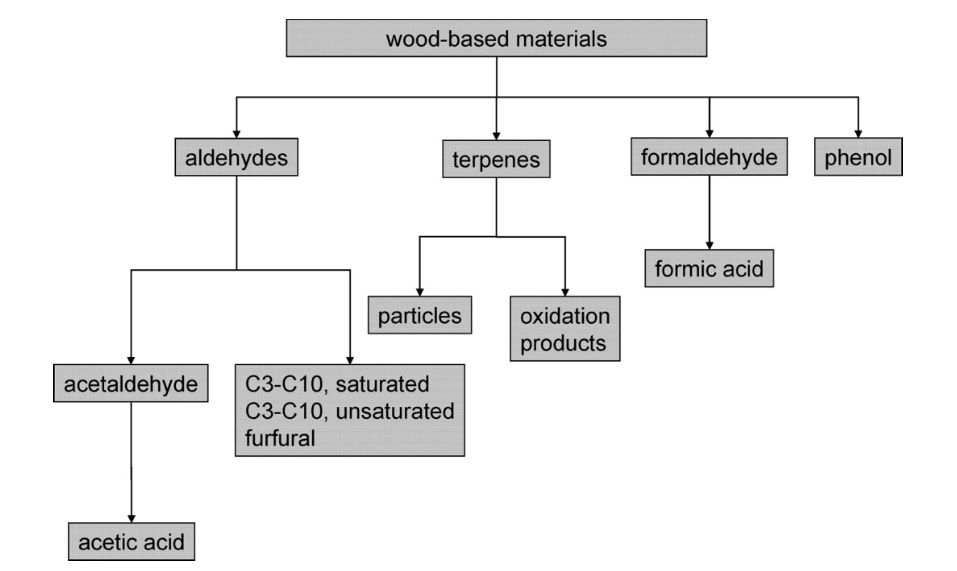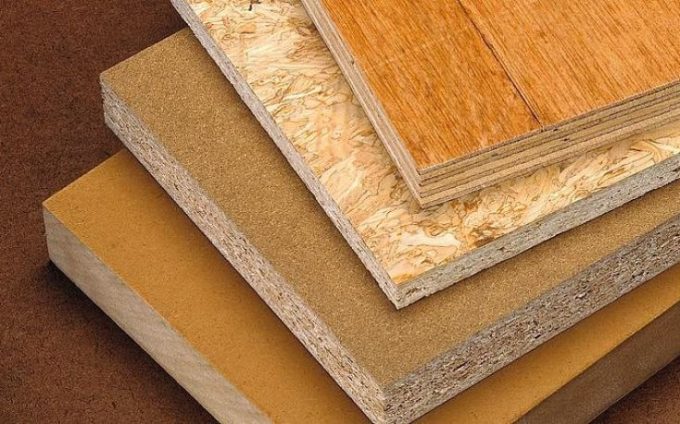Furniture is an important issue of people’s daily life, and everyone is even more aware of it during a move or a change of life. Unfortunately, nowadays the quality is not a purchase criteria. Bookshelves, beds, wardrobes, and cabinet doors are made in wood-based panels, which create Volatile Organic Compounds (VOCs), in particularly formaldehyde. This substance is known for its dangerous impact on indoor air quality, due to the large number of objects. The emissions from furniture represent of total VOCs whereas construction materials represent only of TVOC [4]. Consequently, the WHO recommends a limit of of formaldehyde emission per half an hour in order to protect human comfort, health, and productivity [12].
There are different wood composite products on the market: Chipboards, Medium Density Fiberboard (MDF), Plywood’s and Oriented Strand Board (OSB). They all have different formaldehyde and VOCs emissions. First, the pollutants depend on the raw material: for instance, pinewood emits more alkenes than oak wood [4]. Secondly, according to the manufacturing process, the formaldehyde emissions are higher and uniform in pressed-wood products as chipboards and MDF, while OSB products are characterized by heterogenous profiles of carbonyl compounds [8]. This variability of VOC emissions profiles is directly result from the manufacturing process, due to some techniques such as drying and hot pressing. Changing the vapor pressure during the pressing can reduce VOCs emission in the panel [7].
There are two sorts of formaldehyde sources. First, pieces of wood are stuck together thanks to the urea-formaldehyde resin which is the most used adhesive because of this good curing and low cost. Spraying coating on furniture create a higher concentration of carbonyl compounds than the wood manufacturing process [7]. During furniture coatings, spraying process created a higher concentration of carbonyl compounds as formaldehyde than the wood processing manufacturing. Due to the reversibility of the urea-formaldehyde, the emission lower slowly for months and years [8]. For this reason, nitro coating is used to improve the quality of the products, but it also generates volatile carbonyl substances such as ethyl acetate, benzene and toluene, which have an impact on health [7].
In use, the coating of a piece of furniture is the second source of formaldehyde because of the oxidation of VOCs with ozone and alkenes in the air [7]. More ozone molecules a room contain the more formaldehyde is emitted. Users are even more exposed to this type of formaldehyde since panel covering contains more reactive components and the ratio surface-to-volume is up to [10]. Cleaning products react with terpene compounds and VOCs are emitted [11].

Some volatile Organic Compounds (VOCs) are present in the wood before manufacturing, such as aldehydes and terpenes [7]. However, after transformation, reactive compounds or secondary products are emitted and can be measured in test room: alkenes, alkanes, alcohols, esters, benzene series and aldehydes [4]. The amount and concentration of these substances can vary according to the type of furniture, nevertheless whatever material is used, the emissions will decrease to a steady-state value [4].
The presence of formaldehyde and VOCs in the indoor air is taken seriously by governments. To control polluting sources, some countries in Europe and North America have implemented regulations with standards and labels for indoor decorating and refurnishing materials. The principle of the label is to determine with criteria if testing furniture insures in a room the indoor air quality. In 1978, the first environmental label for construction products and indoor products was created in Germany, Blue Angel [3]. This international ecolabel can guide countries to have a sustainable consumption, all around the world (for example Austria, Switzerland, Korea, and China). The label BIFMA (1973) is less known and was created for only office furniture [3].
Unfortunately, existing labelling systems considered too many volatile substances, on the contrary test made on furniture should target some pollutants. In addition, the determination of the threshold varies according to the standards, the different methods, and the testing time [3]. Finally, standards depend on the weather conditions because the surface of the furniture reacts to the temperature and the humidity of the environment. Furthermore, the amount of furniture is the same room has an impact whereas the standards evaluate the emission only for one little piece of furniture.

For example, the Blue Angel label suggest a limit of after 3-day test or , which is different from the WHO recommendation mentioned before [6]. In Switzerland, recommends a rate of or of formaldehyde [1]. The choice of the threshold depends on odor intensity of formaldehyde the type of environment. Each country should choose its label carefully as the environment varies from one another. The purpose of these recommendations is to reduce the impact of formaldehyde on health. Acrylates and diisoyanates emitted by furniture, even at a low concentration, can cause skin or eyes irritation due to odor intensity [10].
Finally, labels invite manufactures to follow their recommendations but there is a lack of legal rules which prevent from exceeding the threshold limit. Therefore, imported furniture may not respect the values of the purchasing country.
Innovative approaches are being explored to reduce the VOCs emissions during the manufacturing, like hot pressing or transforming bamboo biomass into a fiber-based bio composite, without using formaldehyde adhesives [2]. Removing volatile compounds like aromatics or halogenated hydrocarbons can improve the air quality.
When an empty room is furnished, the rate of formaldehyde increases by . However, as time goes by, the concentration of VOCs stays steady around to in houses and in public buildings [12]. Even if the values are lower than the WHO recommendation, a big new piece of furniture will have a significant impact on the indoor air quality for about one year [4]. In addition to the size and date of manufacturing, the type of material, the number of pieces and the use and the cleaning can increase the emissions of formaldehyde and VOCs in indoor air concentration.
Sources
[1] “Formaldéhyde” OFSP https://www.bag.admin.ch/bag/fr/home/gesund-leben/umwelt-und-gesundheit/chemikalien/chemikalien-a-z/formaldehyd.html (accessed Mai 1, 2021) [2] S. Ge, N. Ling Ma, S. Jiang, “Processed Bamboo as a Novel Formaldehyde-Free High-Performance Furniture Biocomposite”, ACS Applied Materials & Interfaces, 2020, dio : 10.1021/acsami.0c07448 [3] Z. He, Y. Zhang and W. Wei, “Formaldehyde and VOC emissions at different manufacturing stages of wood-based panels”, Building and Environment, vol. 47, pages 197-204, 2012, doi : 10.1016/j.buildenv.2011.07.023. [4] J. Kang, J. Liu & J. Pei “The indoor volatile organic compound (VOC) characteristics and source identification in a new university campus in Tianjin, China”, Journal of the Air & Waste Management Association, 67:6, 725-737, 2017 doi: 10.1080/10962247.2017.1280561 [5] Liu, W., Zhang, Y., Yao, Y. et al. “Indoor decorating and refurbishing materials and furniture volatile organic compounds emission labeling systems: A review”. Chin. Sci. Bull. 57, 2533–2543 (2012), doi : 10.1007/s11434-012-5208-x. [6] “Low-Emission Floor Covering Adhesive and other Installation Materials” https://produktinfo.blauer-engel.de/uploads/criteriafile/en/DE-UZ%20113-201106-en%20Criteria.pdf (accessed Mai 1, 2021). [7] Y. Qi, L. Shen, J. Zhang and J. Yao, “Species and release characteristics of VOCs in furniture coating process”, Environmental Pollution, vol. 245, pages 810-819, 2019, doi : 10.1016/j.envpol.2018.11.057. [8] H. Plaisance, A. Blondel, V. Desauziers and P. Mocho, “Hierarchical cluster analysis of carbonyl compounds emission profiles from building and furniture materials”, Building and Environment, vol 75, pages 40-45, 2014, dio : 0.1016/j.buildenv.2014.01.014. [9] T. Salthammer, S. Mentese, and R. Marutzky, “Formaldehyde in the Indoor Environment”, Chemical Reviews 2010 110 (4), 2536-2572, doi : 10.1021/cr800399g [10] T. Salthammer, A. Schwarz, F. Fuhrmann, “Emission of reactive compounds and secondary products from wood-based furniture coatings”, Atmospheric Environment, vol. 33, pages 75-84, 1998, dio : 10.1016/S1352-2310(98)00128-9. [11] E. Uhde, T. Salthammer, “Impact of reaction products from building materials and furnishings on indoor air quality—A review of recent advances in indoor chemistry”, Atmospheric Environment, vol 41, pages 3111-3128, 2007, dio : 10.1016/j.atmosenv.2006.05.082. [12] P. Wolkoff, G. D. Nielsen, “Non-cancer effects of formaldehyde and relevance for setting an indoor air guideline”, Environment International, vol 36, pages 788-799, 2010, dio : 10.1016/j.envint.2010.05.012.
